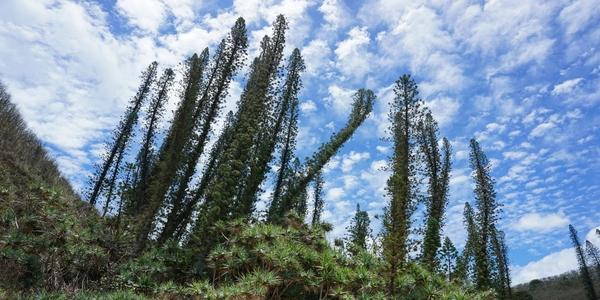Cook's pine, a truly unusual tree, whose characteristic is that it inclines towards the south in the northern hemisphere and towards the north in the southern one. But recently a team of scientists discovered that this particular inclination follows a precise pattern: all Cook pines, in our latitudes or those in the south of the world, always face towards the equator.
Cook pine, a truly unusual tree, whose characteristic is that of lean south in the northern hemisphere e to the north in the southern one. But recently a team of scientists discovered that this particular one inclination follows a precise pattern: all Cook pines, in our latitudes or those of the southern hemisphere, always turn towards the equator.
Trees drunk, the scientists ironically, but it is one of many magic of Mother Nature, which had gone virtually unnoticed. Until now, it was thought that Cook pines (Araucaria columnaris) had this particular "habit" for other reasons, related to the presence of particular local conditions, such as wind, or due to agrowth anomaly.
Cook pines originally came from New Caledonia, the tropical archipelago located in the Pacific Ocean. The trees were first classified during Captain James Cook's second mission.
Today, these beautiful trees are very popular in parks and gardens around the world. They can reach the 60 meters high and they have short branches, but it is their tendency to incline that has made them known.
The botanist Matt Ritter of California Polytechnic State University, noted that in California and Hawaii the pines all seemed to be facing south. He then contacted his Australian colleagues asking them for information about the pines that grew in their area. The answer confirmed what was already known: Australian Cook pines pointed their branches north.
To investigate the matter, Ritter and his team collected measurements from 256 trees in 18 countries and 5 continents, including the species' native range in New Caledonia. The researchers excluded trees whose growth could be affected by other objects, such as a building or electricity pole. They recorded the height of each tree, the diameter of the trunk, as well as the direction of the compass and that of the branches. Cook's pines proved to be very similar in habits.
“We have discovered a surprisingly consistent pattern of the directional slope " explain scientists, whose study was published on Ecology.
On average, pines tilt 8,05 degrees, in the northern hemisphere to the south and vice versa. Less than 9% of the trees studied did not conform to this pattern.

Also the latitude it made the difference: the farther the trees grew from the equator, the greater the inclination. Other than drunkenness, these splendid creatures project their body, their branches, towards the sunlight, it is the so-called phototropism.
But that's not all. Cook pines have a truly exceptional feature, the ability to detect gravity at the molecular leveland then direct roots and branches in the correct directions, towards theequator.
"The mechanisms underlying the direction of A. columnaris may be related to an adaptive tropic response to the angles of incidence of annual sunlight, of the severity, of magnetism or a combination of these, ”explain the researchers.
For other tree news read also:
- THE 10 STRANGEST TREES IN THE WORLD
- CURVED TREES AND EXTRAORDINARY DANCING FORESTS IN THE WORLD (PHOTO)
- IN ECUADOR THE TREES THAT "WALK" AND MOVE 20 METERS A YEAR (VIDEO)
- THE 10 LONGEST TREES IN THE WORLD
Theirs is a solemn bow to the sun, source of light and life.
Francesca Mancuso


























